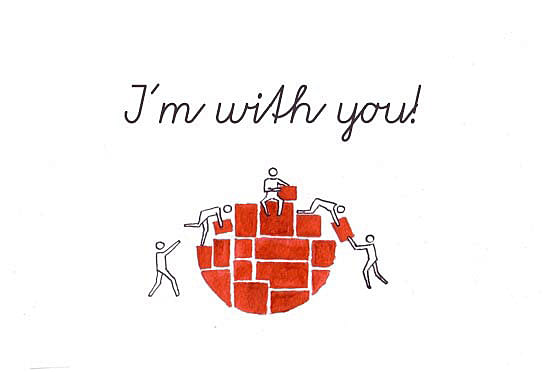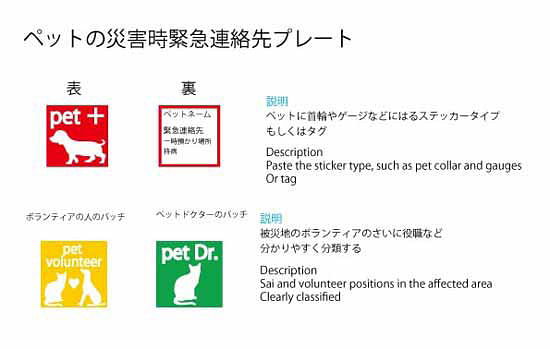Design 21 Announces Winners of 'Help Japan' Competitions
By Bustler Editors|
Wednesday, Jun 22, 2011

Related
DESIGN 21: Social Design Network just announced the results of its ‘Help Japan’ competitions, a multi-faceted effort to support Japan and help provide relief to the disaster areas at different stages of the recovery process.
Two product competitions, based on the design of a greeting card and symbolic charity accessory, were created to provide mid-level support. Felissimo will produce the winning designs and donate 15-20% of the proceeds to the Japan Earthquake Relief Fund. The third competition asked for ideas that contribute to long-term relief, recovery and rebuilding, which Felissimo will share with disaster relief organizations.
Japan Earthquake Relief (Symbolic Accessory)
Entrants were asked to design a small accessory to help deliver the message “I’m with you!” and serve as a symbol of support, love, and solidarity. The winner, as chosen by representatives of DESIGN 21 and Felissimo, was awarded $3,000 and the winning design will be produced and sold by Felissimo with a percentage of the proceeds benefitting the Relief Fund. A “Judge’s Pick” and “Most Popular” design was also chosen. According to UNESCO, “We are truly happy for the enthusiasm that these competitions have sparked, especially during this extremely trying time for Japan.”
Winner: Annisa Fardha Nabila
Design: BOTAN
Origin: Bandung, Jawa Barat, Indonesia
BOTAN (meaning “button” in Japanese), designed by Annia Fardha Nabila, is no ordinary button. Above and below the button holes are additional engraved shapes that give the impression of two people standing. When a string is inserted through the holes, it looks like they are holding hands, expressing the message, “I’m with you!” Crafted from wood with a red-ish hue to represent Japan, BOTAN can be used as a myriad of fashion accessories, whether a necklace, bracelet, key chain or button. As UNESCO states, “The color red, the button hole design, and the concept of thread symbolizing connection are what led us to select BOTAN as the winner.”

Judge’s Pick: Mariana Isaza
Design: Put a Smile on Japan
Origin: New York, NY
Put a Smile on Japan is a series of pinback buttons that can be produced in 5 different sizes ranging from 1.25” – 6” in diameter. According to the designer, Mariana Isaza, “The purpose is to start a ‘virus’ of good will and positive thoughts towards Japan. A smile breaks the ice and eases tension, but most importantly, it is infectious.”

Most Popular: Mikheil
Design: Feel
Origin: Tbilisi, Georgia
The form of Feel is based on entwined hands, representing the support of people. The red ball located in the center represents the unity of people and is a symbol of light, strength and the culture of Japan. Designed as a universal form, it is suitable for males and females and as earrings, a necklace or bracelet.
Honorable Mentions were also awarded to Pomme van Hoof, a product designer from the Netherlands, and Shakari, a designer from Jakarta, Indonesia.
Japan Earthquake Relief (Greeting Card)
DESIGN 21 asked its members to create a series of greeting cards that expresses the sentiment “I’m with you!” to convey hope, connectedness, and other positive thoughts to people in Japan. Representatives of DESIGN 21 and Felissimo chose one winner, who received a $500 prize. The winning greeting card design will be produced and sold by Felissimo with a percentage of proceeds benefitting the Relief Fund. Two other designs were awarded an “Honorable Mention” and “Most Popular.” UNESCO hopes to eventually produce a book of designs featuring the ‘Help Japan’ message.

Winner: Gréta Mihály
Design: I’m with you!
Origin: Budapest, Hungary
Gréta Mihály’s design features a symbolic interpretation of the Japanese flag, with people helping one another to rebuild a red circle composed of building blocks. According to UNESCO, “We love this concept of many people coming together to rebuild Japan.”

Most Popular: Astronutlab
Design: Japan… I’m with you!
Origin: New Jersey, USA
In response to the Japan earthquake disaster, the NJ-based graphic design team, Astronutlab, created three powerful greeting card designs. The first, entitled “Hurt”, demonstrates the hurt felt by Japan with an illustration of a red circle with a sad face. The second, “Giving hand,” is a drawing of two hands reaching out to help one another. The third, “Best Wishes,” uses the symbolism of an origami bird to express best wishes to people.

Honorable Mention: Maya Karasova
Design: IloveJapan
Origin: Kosice, Slovakia
The Slovakia-based designer, Maya Karasova, created a greeting card based on Milton Glaser’s famous “I love New York” graphic. Using a softer typeface and red circle, it expresses warm feelings, similar to the heart in the original logo. She was selected to receive an Honorable Mention by UNESCO who states, “This entry has the potential to speak to a lot of people who want to show their support to the people of Japan.”
Calling for Power of Design in Action
For this competition, DESIGN 21 wanted designers to focus on long-term planning for disaster relief, recovery and rebuilding and develop a design solution to a known or imagined problem. Three designs were chosen to be shared with disaster relief organizations for further improvements and possible implementation. They were also awarded $500. As stated by the judging panel, “We hope this competition challenged designers to think more about how to apply their skills to solving important issues.”

Most Popular: Ayan Bhandari
Design: Jinsei
Origin: USA
Feeling that the current blood testing process is not sufficient enough to meet demands during a natural disaster, Ayan Bhandari designed Jinsei. It combines the advancements of disease testing with the process of industrial design to create a faster, more efficient way of testing blood for HIV, Syphilis and Hepatitis B and C at disaster sites. Instead of using four to eight vials to test for different diseases, Jinsei uses only one or two. The threading and cap allows the blood to be stored longer without letting it thaw, making it re-testable in the future. As Ayan puts it, “Blood is the fragile scarlet tree we carry within us and we must protect it and use it to save those in need.”

Judge’s Pick: Yukarin
Design: Volunteer for the pet plate
Origin: Japan
The pet plate is designed to help classify animals during a disaster. The red graphic is a sticker or tag with the owner’s emergency contact details that attaches to a pet’s collar before a disaster. The green plate identifies volunteer animals in affected areas.

Judge’s Pick: Claire Irvine
Design: SHELLter
Origin: London, England
SHELLter is an enclosure designed to address three main problems in the aftermath of a natural disaster. It should serve as housing for those left without adequate shelter. It is lightweight, transportable and reusable. And, most importantly, it should have easy assembly meant for unskilled people, aid workers and local residents.

Judge’s Pick: ein sof
Design: The Needs Triage
Origin: Quezon City, Philippines
The Needs Triage is focused on three phases of emergency management and refugee assistance. It is a wearable tag that gleans as much essential information about the refugee as possible in order to fulfill basic needs (food, medical, psychological, etc.). The Needs Triage also keeps track of refugees and acts as a meta-Needs Triage, helping to determine resource allocation for all areas affected. Lastly, through the use of QR codes and barcodes, The Needs Triage helps people find and connect with their loved ones affected by the emergency situation.
Images courtesy of Design 21.

Share
0 Comments
Comment as :